Mount Bona
Wrangel
- Saint Elias National Park Alaska
May
12 - 24, 2001
Our
expedition notice and postcard:
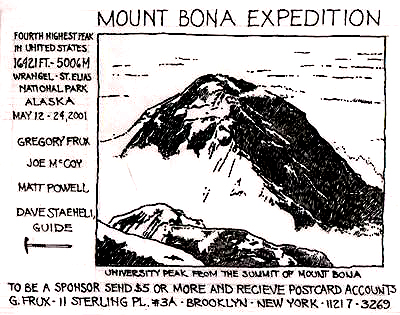
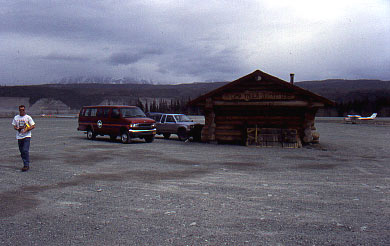
Chitina Airstrip.
This is as far into
Wrangell-St. Elias
National Park as we got by car.
From here all travel
was by air.
|
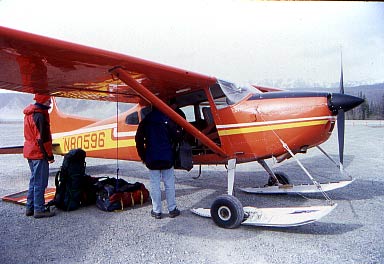
Loading the
Cesna 185. No seats, no beverage
service,
but
the inflight movie was great. We took
this plane
on our
first leg travels into the National Park.
It was a forty minute
journey along a glacial river to
a remote luxury
lodge (accessible only by plane) "Ultima Thule".
|
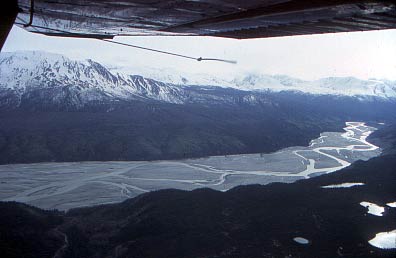
Here is a view out
the window of the plane
as we followed braided
river bed up into the park.
Altitude around
3000 feet. I was in the copilot
seat.
|

On some medieval
maps the remote and inaccessible
north was call "Ultima
Thule". This wilderness lodge, by the same
name, is on an inholding within the National Park.
Accessible by airplane, it is generally
a luxury type facility
catering to only a few travellers at a time-- but
they do also host climbers. We flew in here before heading
on to the mountain. Bad weather
higher up
kept us here two nights. There are plenty worse places
to get stuck! We played with fifty sled dogs, used the sauna,
checked our gear and feasted.
|

We had to wait
two nights at the lodge. Dave Staeheli,
our guide used some
of this time to instruct us on the
finer points of
Alaskan climbing. He is a very accomplished
guide,
having been on Everest and working in the
mountains
of New Zealand. What
impressed us particularly
was his winter climb of Mount McKinley--
solo.
Here Dave
is explaining
where to stick a picket.
A picket is the big aluminum stake he is
holding-- it can
be used as an anchor
in deep snow.
Where to stick it
is on the side of your backpack, where you can get
it, but it won't fall off.
(What did you think
I was going to say?)
|

While waiting at
Ultima Thule, we practiced our skills.
The biggest danger
on Bona is falling in a crevasse.
There
are
many ways to get out of a crevasse
while hanging on
a rope.
One is a self
rescue using sliding knots (prussiks).
It is pretty strenious,
with much of the effort being getting
the backpack off
and assembling the system. Here
we practice in a barn while
hanging from a overhead
beam. See the ladder... well first you
climb the ladder,
then Dave kicks
it out from under
you...
|

The secret of
Ultima Thule. Fifty sled dogs,
five puppies, don't
mind the noise,
go pet them-- no
waiting.
|

We were two
days at Ultima Thule waiting for the weather
to
clear at higher elevations.
Six a.m. day two there
was a
banging on our bunkroom door--the
pilot screaming,
"Weather is clearing,
LETS GO!" Fifteen minutes later we were
lifting
off the dirt runway, the Beaver rising
rapidly.
The flight was one of the most spectacular
parts of the trip...
|
|
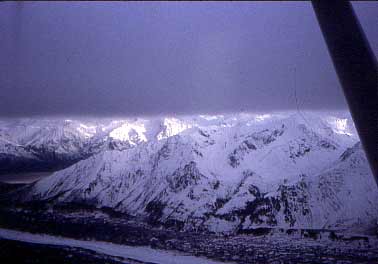
Up past snow covered
peaks with glaciers below. At this
point we were pretty
worried about that cloud ceiling--
the pilot need to
be able to see up to 11,000+ feet
in order to get
us up onto the glacier on Mount Bona...
|

We break out of
the clouds... hey, what is that in front
of us? The Beaver
rises in the cold clear air passing by the
14,000 foot high
pyramid of University Peak
and on towards our
goal.
|

We begin to
descend to an open glacier.
Or rather, we flew
level up the valley
as the ice river
rose towards our skids...
In a minute or five
we will be on the snow.
|

Our plane touches
down on the glacier as smoothly on
skis as the best
airport landing. Smoother in fact, because we are landing
uphill and the plane comes to
a rapid stop.
As we halt the pilot turns a sharp 180, so as to be facing
downhill for takeoff. Then comes a mad scramble to
unload. I hand the pilot some postcards to
take out and within a minute or two he roars
off. Leaving us standing alone, likely the only people
within fifty miles in any direction.
|
Here we are then
at 10,600 feet on a glacier, sun blazing at 8 am. Dave says, "best thing about flying in is that you can tell that
there are no crevasses where we land." (Does he mean that we know
there aren't because... what? if there were,
the plane would have fallen in?) Dave marks a boundary with wands
and instructs us that for the duration
of trip we are never to go beyond that boundary without roping up. We almost start
to feel the cold - zero or minus ten- when we begin our first task,
building camp.
This job will
keep us warm for several hours to come... |
|

First thing on the
ice, we needed to build was a safe camp.
This involved about
two and a half hours of sawing snow blocks to build
walls to protect our tents and cooking area.
Hot and demanding
work at altitude.
We got the tents
up, but our work was not done. Base
camp was built,
but next we would need to carry a load up
to Camp One.
This was particularly urgent since we had
lost two days due
to bad weather...
|
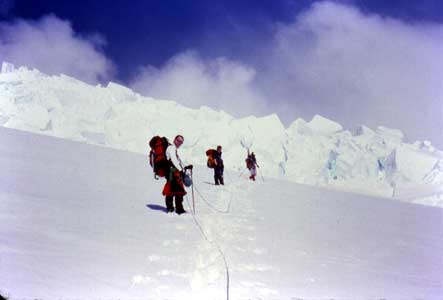
No rest
for us! After building our base camp, we charted our
route up to
camp one. Dave went first, probing for crevasses
and marking
our safe path with bamboo poles with bright tape
(wands). Dave had a superb instinct for avoiding crevasses--
on this very crevassed mountain. We crossed only two
or three,
each less than a foot wide. You can see an ice fall
behind us.
This day we we carried a load of food and fuel
up to around
12,200 feet and cached it.
The following day
we carried a second load and moved
the camp up.
The first day was my hardest-- rapid change in altitude and
alot of work, plus it was too sunny!
Back down to base
camp for a Cajun shrimp and rice
dinner, then twelve
hours sleep in our -20 degree bags.
|

We had great
views right away. Here we are about
1000 feet above
our base camp. You can see wands and
our footprints.
We are perhaps the only people
for thirty miles
in any direction.
|

Here we are
at Camp One, elevation 12,200. When we went into
shade temperatures dropped to minus ten, maybe even minus
twenty. Shadows came to camp around 7 pm and dusk lasted
the next four or five hours. Our route downhill is seen
bearing left and up with several wands. Also visible is
the faint line of our camp boundary.
Peaks across the
valley are around 13,000 feet high.
|
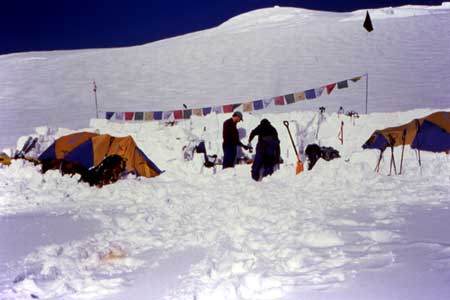
Camp One at
around 12,200 feet elevation. We had to
dig more here as
the slopes were steeper. Kitchen is in
between the tents.
False summit of Mount Bona behind us. Got one very sunny day here
where temperature reached 90 degrees inside the tent.
(Outside was still
pretty cold)
Handy decorator
idea-- Tibetan Pray flags brighten up any
camp. Thanks to Matt for that, after last year's
soggy Tibetan trip.
|

We continued
moving loads of equipment higher,
climbing in two
good weather days from Camp 1 (12,200 ft) to Camp
2 (13,800 ft). We were getting well adjusted to the altitude and
the weather was sunny and clear.
As we got higher we could see more and more
of the superb views
we had hoped for including Mt Logan (19,550
feet) second highest peak in
North America, Mt.
Saint Elias (18,008 feet) fourth highest and Mt.
Foraker (17,400 feet) the sixth highest!
|

High camp, elevation
13,800 feet. Only hours after
building camp 2,
the weather turned sour. Winds rose,
the temperature
dropped and it started snowing. For
the next 36 hours
this was pretty much my view. Our
snow walls, strong
tents, minus twenty degree bags and
lots of hot drinks
kept us comfortable. It stayed very
bright and I kept
hoping for a break in the storm
and a dash to the
summit, but it was not to be...
The real crisis
came when despite oxygen deprivation I finally finished
the 550 page Doctor Faustus by Mann.
And my only other
book was at at camp 1, oh horrors!
|

After a twenty four
hour blow the sun came out shining brightly on our tents. I had visions of starting
for the summit at
four pm (which was theoretically
possible since it
never got dark!). When I got outside and saw
this cloud structure over the summit
I knew it was not
to be. These lens shaped, "lenticular" clouds form when wind speeds
are over 100 m.p.h.
I asked Dave and
he agreed,"No go". What's more, he
said that
the storm wasn't over.
He was right.
This view inspired a painting I created back in New York. Storm, Mount Bona.
|
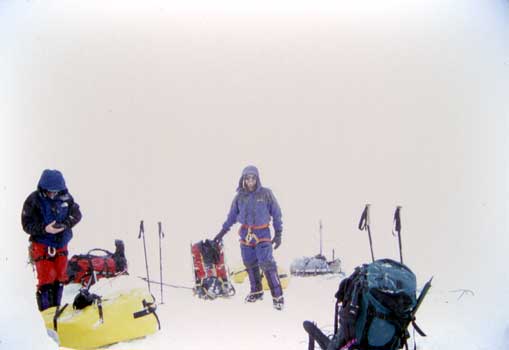
The second morning
of the storm, our time had run
out to attempt the
summit. We packed up in the
blowing snow, assembling
packs and drag bags and roped up.
Dave said
we were safe to descend as long as we could see
from one wand to the next.
He was a pretty
amazing route finder and we were very
glad that he had
marked the route
so well with wands.
|

Portrait during
storm, I look like I am wearing everything
I own, but I am
still carrying the down parka.
|
We retraced our route
down the mountain in around four hours, carry all that remained of our
gear in our packs and drag bags. Mostly we could see only fifty
feet, just making out the next wand. We stayed pretty warm despite
the wind and blowing snow until we got down to the plateau where the plane
had landed us. Here the wind was fierce and ice formed on my whiskers.
It seemed rather desperate to me as we fought our way back to camp.
Then Dave suggested we all stop and take each others pictures because it
looked really cool...
So I figured things
couldn't be too bad!
Looked like no plane
was coming to rescue us this day, so we put the tents back up in
the walls
we had left at base
camp. And I settled in with my second book!

Marginal weather
in the morning, with blowing snow
and a cross wind
of about 20 mph. At 8 am we heard our plane flying
over. Dave got on our line of sight
radio. Pilot
asked if we wanted out today-- He thought we
were coming out
the next day! He told us to get ready.
We packed up and
waited. It was the coldest two hours
of the trip in the
lee of the snow walls. Dave explained
all the the shelters
he could build with a shovel and nylon
bag...
|
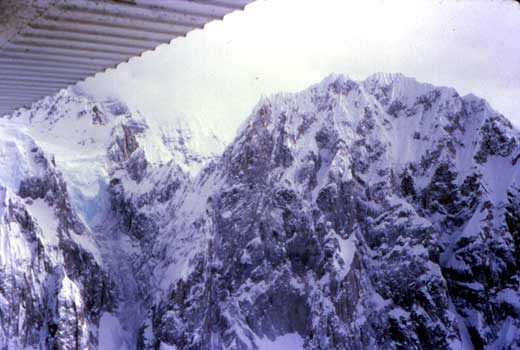
The last picture.
At 10 am our pilot
landed using our lined up partly
frozen bodies to
guide him on in. We ran to turn the
plane down-glacier
and then to load it. A spectacular
flight out, followed
by a sauna, a good meal, another
flight, a drive
and another good meal.
During our
flight off Bona
we flew by many shear faces like the one in this picture.
At the bottom of one, we saw two
tiny figures.
They were two world class mountaineers,
one of them being
Carlos Buhler, who has climbed a
route up Mount Everest
that has never been repeated.
We ended up having
lunch with them later. They had tried a shear rock
face coated with many feet of ice and
frosting at the
same time we were on Mount Bona. They were turned back
by continuos avalanches-- said it was like vertical surfing. We felt
a little better about not summiting.
|
|
|
























